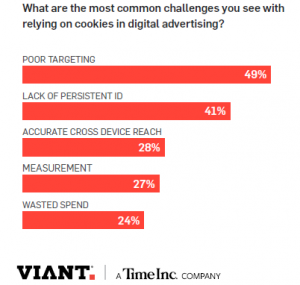People-Based Marketing Is Key to US Ad Industry. In a Recent Report, Viant Tracked How People-Based Marketing Is Making a Huge Impact on the US Advertising Industry

In February, Viant, a Meredith Corporation people-based advertising technology company, had announced a major enhancement to their partnership with Factual, the leading location data provider. Through a direct integration, Viant customers gained access to real-time foot traffic measurement and industry-leading reporting powered by Factual’s location data through the Viant Advertising Cloud. The company also unleashed a powerful report on how People-Based Marketing is making a huge impact on the US advertising industry.
To understand how US advertisers can benefit from the new-age people-based marketing standards postulated by “Power of The People” report, we spoke to Viant CMO, Jon Schulz.
People-Based Marketing Is Important to Justify Your Ad Dollar Spend in 2018
Why is People-Based Marketing suddenly so important to justify ad dollar spend in 2018?
Marketers are being held to much higher standards and are gradually shifting away from simple metrics like clicks. As ad spend shifted from traditional channels into digital and mobile advertising over the course of 2017, marketers had to broaden their skill set to better understand their customer base and ultimately maximize their impact across all devices. The ability to know whether you’re actually reaching the person you intend to target is crucial to the success of a campaign and to reduce the wasted ad spend.
“People-Based Marketing enables marketers to move beyond anonymous cookies and third-party data to reach real people by leveraging a user’s registered profile and the data points that come with it. As a result, marketers actually get to know the person behind the screen in order to better anticipate their needs at different points in their lifecycle.” – Power of the People, by Viant
Read More: Interview with Jon Lombardo, Global Brand Strategy Lead, LinkedIn
Marketers want access to high-quality audience data, brand-safe inventory, and reporting that shows a measurable impact on the bottom line. Providing insight on consumers down to the individual user level enables marketers to communicate with the right person, at the right time, via the right device, rather than targeting an anonymous audience with cookies and hoping for the best outcome.

Additionally, analyzing first-party data to better understand which ad campaigns resonate across a consumer’s entire path to purchase — which often involves a combination of both online and in-store data — all comes down to executing a people-based approach.
People Based Marketing Is a More Powerful Evolution of Behavioral Marketing
How should brands juggle between Behavioral Marketing and People-Based Marketing?
Behavioral marketing is powerful because it enables marketers to target audiences based on their specific behaviors across the web, for example, what products or purchases they have made, what websites they visit or what their particular interests are. Behavioral marketing can lead to higher engagement, increased relevancy, and a greater return on ad spend.
People-Based Marketing and behavioral marketing can be used in concert to power a highly effective campaign optimized for success.
People-Based Marketing is a more powerful evolution of behavioral marketing, combining not just consumer behavior but real people and their connected devices leveraging registered user data. By linking a user’s profile with their behavior marketers can gain a single view of the consumer to deliver more relevant and more effective advertising.
Targeting Inaccuracies: How People-Based Marketing and Location Data Solve the Puzzle
What are the ‘Targeting Inaccuracies’ that pose biggest challenges to Digital Advertising?
Marketers are constantly trying to tie media directly to sales and understand how marketing initiatives move product, as opposed to measuring proxies or generic metrics like clicks. Relying on a probabilistic cookie-based approach will lead to inefficient targeting. A marketer has to be able to identify and engage with the right audiences.
Targeting inaccuracies are often the result of not having access to the right kind of audience or behavioral data, but People-Based Marketing at scale ensures marketers can reach the right person at the right time with the right message.
Marketers need accurate targeting data about their audiences, and targeting based on demographic information, psychographic, location, and purchase behavior, for example, is crucial. However, this is easier said than done and requires access to a robust consumer profile. A successful marketing campaign requires accuracy and scale and many marketers are left reducing the quality of their efforts because they make a sacrifice for one or the other.
Recommended Read: TechBytes with Shouvick Mukherjee, Chief Technology Officer, Amobee
Using People-Based Marketing, Brands Gain a Holistic View into All of Their Marketing Initiatives
Would Digital Advertisers manage to answer Attribution queries completely with People-based marketing analytics?
Multi-touch attribution (MTA) enables a more granular examination of all channels and touchpoints. But for marketers, retaining control of customer data that is truly meaningful, remains a challenge. The beauty of MTA is that it allows you to look at different channels across the path to purchase to see what contributed to the ultimate conversion.
Read More: Is GDPR Really Changing Ad Tech?
But it’s only possible for marketers and agencies willing to get their hands on their data and reframe their view from pricing to conversion-based measurement. With People-Based Marketing, brands gain a holistic view into all of their marketing initiatives by linking together these disparate data sources.
The Challenges and Opportunities in the US Ad Industry
What is the State of Digital Advertising in 2018? How is it changing with Brand Safety, Transparency, and Programmatic technologies?
Digital advertising is heading towards a place where the industry is placing a higher priority on creating much more meaningful interactions, so not only is there an emphasis on the need of marketers, but also on building high-quality engagements with consumers that spark meaningful relationships with their brand. This “flight to quality” means less focus on the lowest CPM or highest CTR and more of a premium on viewable ads by real people in quality environments.

Digital advertising can lack the personal nature of face-to-face interactions that in-store environments provide, and there is the added challenge of both identifying and then reaching the right audience. Marketers are searching for ways to solve these challenges, and are increasingly finding the answer in People-Based Marketing.
Successful People-Based Approach for Brands
The latest Viant clearly demarcates the boundaries for US digital marketers. Clearly, the current crop of digital marketers is struggling to leverage partners that can help them expand their People-Based Marketing at scale.
“We believe 2018 will be a watershed year where we see the widespread adoption of People-Based Marketing by brands and agencies, delivering more personalized and effective ads across the entire web.” – Power of the People, by Viant
Viant suggests three factors that are critical to building a successful People-Based Marketing approach for brands —
Scale Your First-party Data
Viant recently acquired Adelphic to provide marketers a global-level people-based DSP, an industry-first solution.
Recommended Read: Salesforce Einstein Analytics Unveils Conversational Queries to Simplify Data
Focus on Accuracy
People-Based Marketing strategies should provide an all-conclusive view of your audience across the TV, mobile, desktop, DOOH, and in-store purchasing activities.
Density
When you know how many people you want to reach, you can bolster your CRM accordingly.
Viant’s partnerships with companies such as Nielsen Catalina, Experian, and Urban Science helps in building a rich picture of an individual, bolstering the data held in a brand’s existing CRM system – such as the type of car they drive or the retailers they’ve recently visited.
Read More: S4M Co-founder Stanislas Coignard Takes Over As US CEO to Focus On US Expansion











